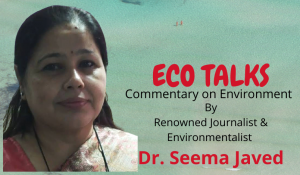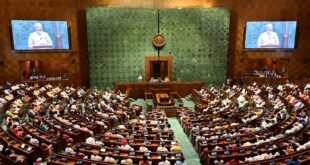Dr. Seema Javed
 While it is commonly assumed that air pollution is a winter problem, government data shows otherwise. A deep dive into air pollution data of the Central Pollution Control Board (CPCB) across 10 cities showed that monthly PM 2.5 and PM 10 levels during the summer months breached the annual CPCB safe limits of 40 ug/m3 and 60 ug/m3 respectively during most months.
While it is commonly assumed that air pollution is a winter problem, government data shows otherwise. A deep dive into air pollution data of the Central Pollution Control Board (CPCB) across 10 cities showed that monthly PM 2.5 and PM 10 levels during the summer months breached the annual CPCB safe limits of 40 ug/m3 and 60 ug/m3 respectively during most months.
Despite alarming high levels, air pollution continues to be a winter problem. Policy decisions and action focus on the problem for the few months of winter. It is the prolonged exposure to high pollution levels throughout most of the year that impacts human health. According to a recent study commissioned by the Energy Policy Institute (EPIC) at the University of Chicago, air pollution has shortened life expectancy in New Delhi by up to 10 years, and across the country by five years.
Adding to the existing meteorological factors that keep the air pollution levels high during summer, this year also saw multiple heatwaves and a poor show of pre-monsoon showers especially in the northwestern plains.
For the purpose of analysis, 10 non-attainment cities – Agra, Bengaluru, Chandigarh, Chennai, Delhi, Kolkata, Jodhpur, Mumbai, Lucknow and Patna were selected and average PM 2.5, PM 10 and NO2 levels were looked at for the months of March, April, May and June. While the Indian Meteorological Department considers June as a monsoon month, it is mostly dry in several parts of the country and hence part of our summer time pollution analysis. The CPCB’s annual average permissible limits for PM 2.5, PM 10 and NO2 are 40 ug/m3, 60 ug/m3 and 40 ug/m3 respectively. The World Health Organisation’s safe limits are lower at 5 ug/m3, 15 ug/m3 and 10 ug/m3 for the three pollutants respectively.

How the cities fared in the summer months this year?
According to the data, all cities except Chennai recorded higher than permissible PM 2.5 levels in March 2022 and all cities breached permissible limits for PM 10 levels. In April, levels improved only in Kolkata and it joined Chennai in the cities which did not breach safety limits for PM 2.5. Chennai was also the only city with PM 10 levels in safe limits during April. Similar trends continued in May when only Chennai, Bengaluru and Kolkata saw PM 2.5 levels within safe limits and no city met the safety standard for PM 10 levels. With some parts of the country receiving rains in June 2022, five cities – Agra, Bengaluru, Chennai, Kolkata and Mumbai saw their PM 2.5 levels improve and within the CPCB safety limits. PM 10 levels were under 60 ug/m3 during June in Bengaluru, Chennai and Mumbai.
2021 vs 2022
This year, the country was reeling under multiple heatwaves from as early as March with record breaking temperatures all across. March was the warmest in 121 years and the country recorded an average maximum temperature of 33.1 degree Celsius, an all-time-high and 1.86 degrees Celsius above normal levels. Similar trends continued in the following months.
With the extreme heat also came a power crisis that resulted in more coal burning, a primary source of pollution. Extreme heat combined with stagnant air during a heatwave increases not only the amount of ozone pollution but also particulate pollution. Locally, these prolonged dry spells during the summer months also mean more dust resuspension in the air. Adding to the summer woes was the poor show of pre-monsoon, the especially for northwestern plains which are also hotspots for air pollution.
Evidently, the PM 2.5 and PM 10 levels were higher this year compared to 2021 in most of the cities, most of the months in this analysis. For instance, Delhi PM 2.5 and PM 10 levels were higher in 2022 as compared to 2021 across the four months except in the case PM 10 levels in March. Similar was the case in Patna. In both cities, the levels are over five times higher than CPCB standards. (Data for other cities analysed is in available in the data sheet.)
The pollutant-share during summers
While the PM 2.5 levels are more than permissible limits in the 10 cities, the PM 10 levels are significantly higher and is the prominent pollutant. Data analysed shows that eight of the 10 cities did not see PM 10 levels in the safe limits throughout the four months in 2022. Bengaluru’s PM 10 concentration of 58.49 ug/m3 in June 2022 barely met the safety standard when the city had already received over 200 mm rainfall. Similarly, Chennai’s PM 10 concentration met the safe limits in April and June this year.
Also read : Fuel left for a day only, Extended holiday at Sri Lanka schools
Among the 10 cities, Nitrogen dioxide (NO2) breached annual safety limits of 40 ug/m3 in the cities of Patna and Delhi during March and April this year and in Chandigarh from April to June. While within permissible limits in other cities, several of them like Agra, Chennai, Jodhpur and Kolkata saw an increase in levels as compared to the previous year. NO2 is an irritant gas, which at high concentrations causes inflammation of the airways.
 Jubilee Post News & Views
Jubilee Post News & Views





